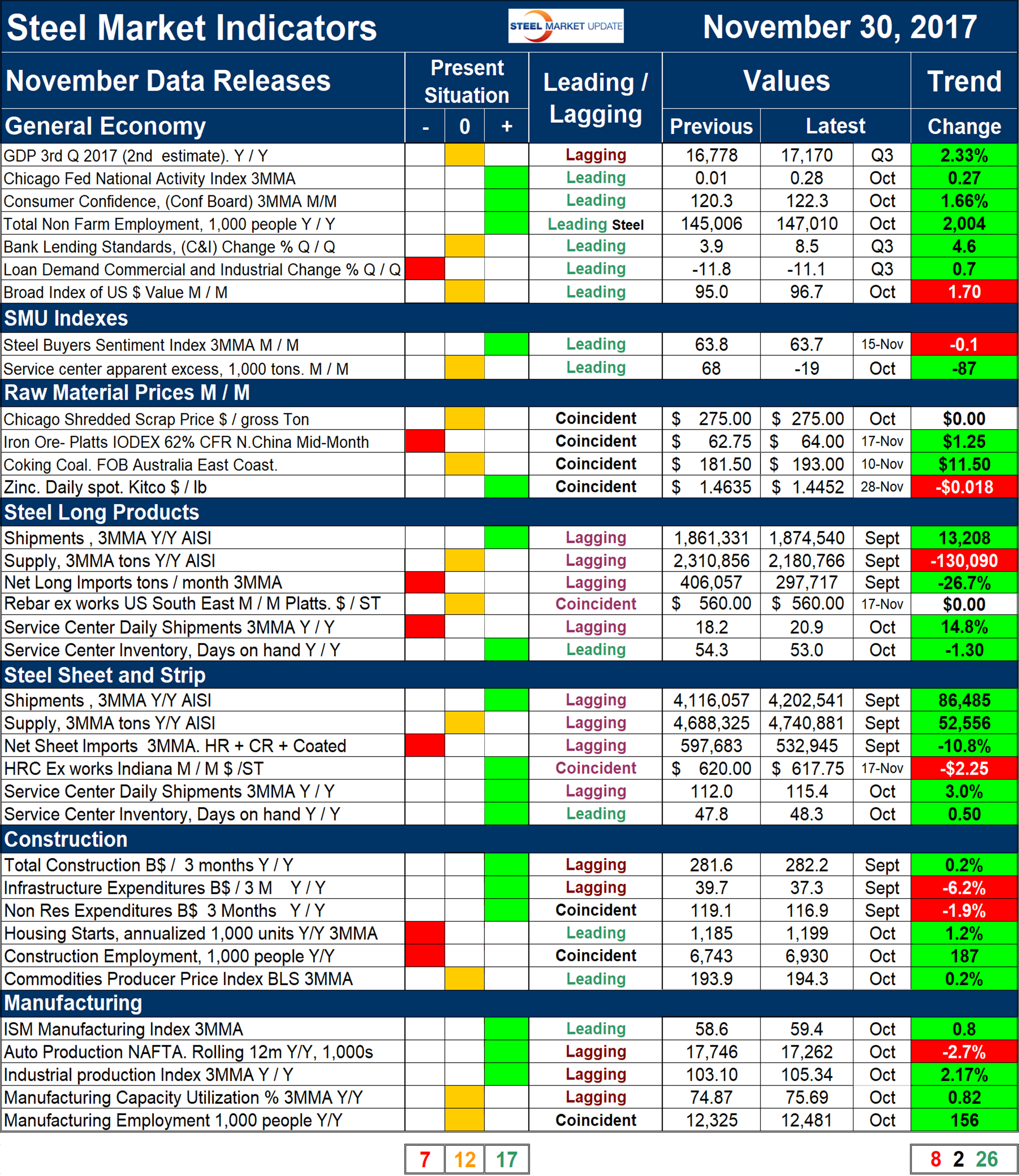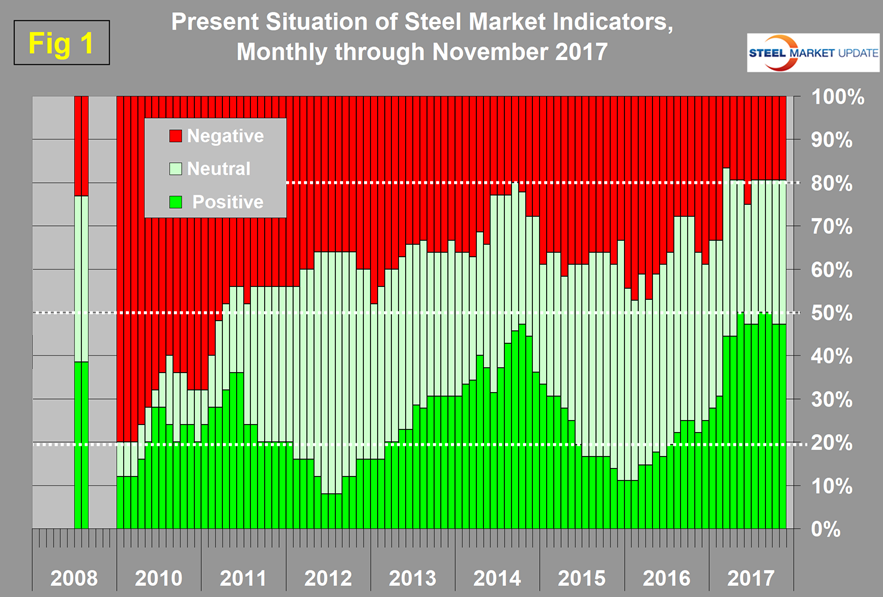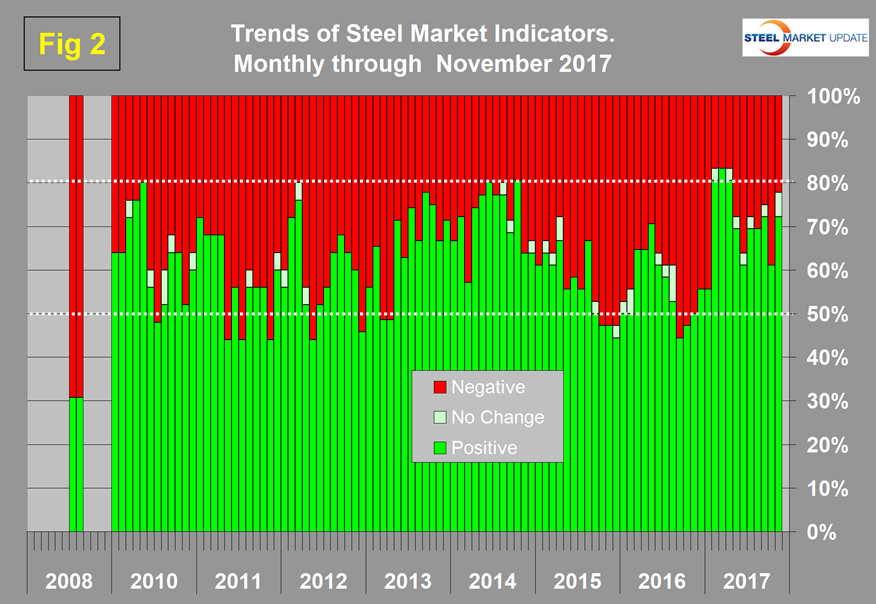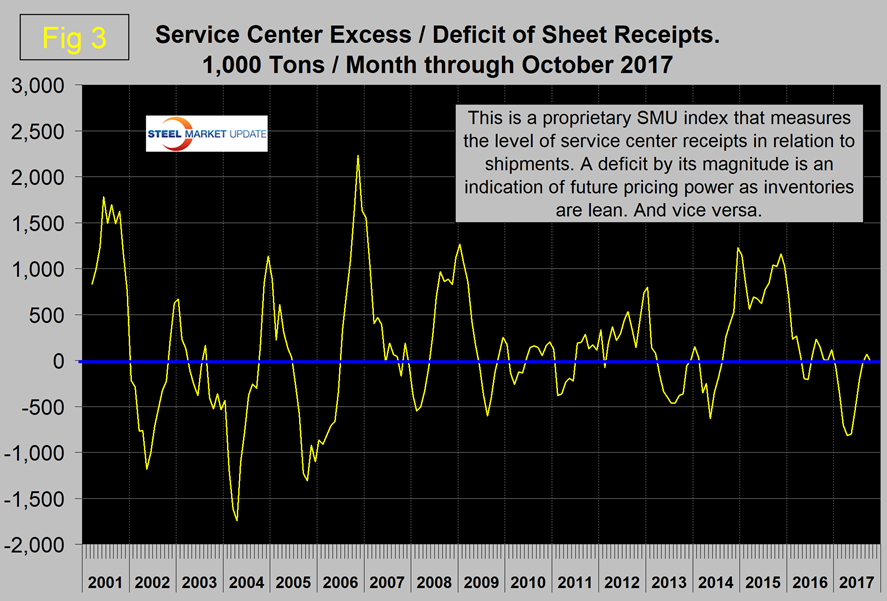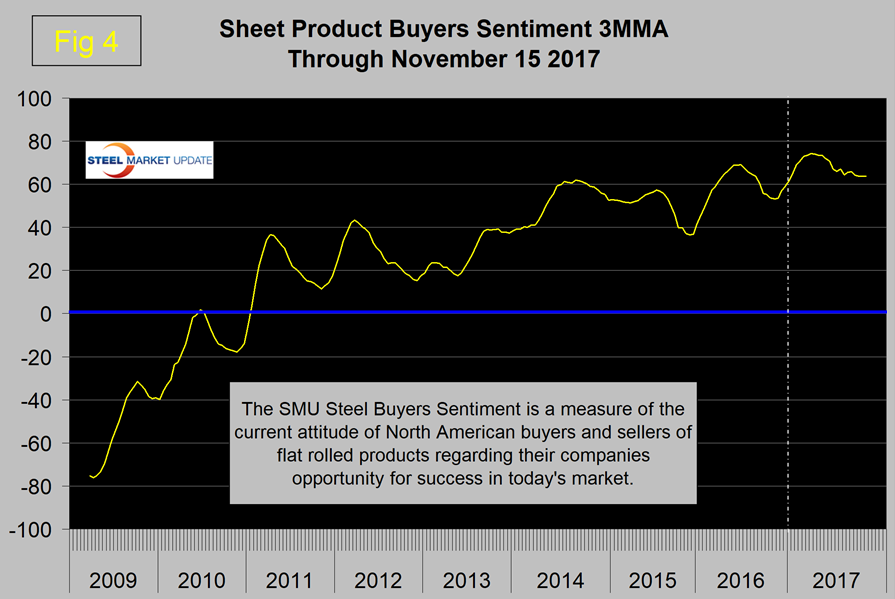SMU Data and Models

Key Market Indicators Improve in November
Written by Peter Wright
December 3, 2017
Steel Market Update’s steel market indicators show improved trends in the November data.
In our examination of data released in November, our view of the present situation is that 47.2 percent of the 36 indicators are historically positive with only 19 percent negative. The balance is within the band of historically normal. The total of positive and normal has not changed in five months, something that has not previously happened in our eight-year history of this analysis. Trends improved with 72.2 percent of the indicators heading in a positive direction; this was up from 61.1 percent in October, but was the same as September. Trends lead the present situation by about four months.
![]() An explanation of the Key Indicators concept is given at the end of this piece. This will explain the difference between our view of the present situation, which is subjective, and our analysis of trends, which is based on the latest facts available. The total number of indicators considered in this analysis is 36.
An explanation of the Key Indicators concept is given at the end of this piece. This will explain the difference between our view of the present situation, which is subjective, and our analysis of trends, which is based on the latest facts available. The total number of indicators considered in this analysis is 36.
Please refer to Table 1 for our view of the present situation and the quantitative measure of trends. Readers should regard the color codes in the present situation column as a visual summary of the current market condition. The “Trend” columns of Table 1 are also color coded to give a quick visual appreciation of the direction in which the market is headed. All data included in this table was released in November, the month or specific date to which the data refers is shown in the second column from the far right and all data is the latest available as of Nov. 30, 2017.
Present Situation
There was no change in our perception of the balance of indicators in November between negative, neutral and positive though there were changes in the detail. We currently view 17 of the 36 indicators as positive, 12 as neutral and 7 as negative. Our intent in using the word neutral is to say that this indicator is considered to be in the mid-range of historical data. Among changes in November, the Chicago Fed National Activity Index was re-classified from neutral to positive and the supply of long products was revised from positive to neutral. Figure 1 shows our monthly assessment of the present situation since January 2010 on a percentage basis. The indicator classification has been remarkably consistent for the last nine months with the combination of positive and neutral indicators being above 80 percent for eight of those months. This is the best string of results since we began this analysis in January 2010.
Trends
Most values in the trends columns are three-month moving averages (3MMA) to smooth out what can be very erratic monthly data. Trend changes in the individual sectors since the end of October data are described below together with some general comments. (Please note in most cases this is not November data but data that was released in November for previous months.)
In the four months November 2016 through January 2017, there was a steady improvement in trends. There was a positive surge in February that was sustained in March and April. Since then results have been mixed with November data recovering from October, which had the highest number of negatives since January. Figure 2 shows the trend of the trends and the pre-recession situation at the far left of the chart.
Our observations about trends in the November data are as follows: the second estimate of GDP growth in the third quarter was released yesterday and was revised up from 3.03 percent in the first estimate to 3.26 percent. This is an annualized change quarter on quarter. Our key indicators chart records year-over-year changes and by this measure in Q3 the economy grew by 2.33 percent, which was the best result since Q3 2015. In the General Economy section of Table 1, there were two trend reversals. Demand for commercial and industrial loans improved from the second-quarter result and the value of the U.S. dollar on international exchange markets reversed direction and strengthened. Six of the seven general economy indicators are heading in the right direction. There was one change in the direction of the trends of the SMU proprietary indexes. Service center excess of sheet products became increasingly negative through April this year when it reached negative 816,000 tons. Since then, the deficit declined to a mere 19,000 tons in October with a blip to a surplus of 68,000 tons in September. This is a proprietary SMU calculation. We regard an inventory deficit to be positive in terms of pricing power, therefore we are presently in a situation of negotiation neutrality (Figure 3).
The steel buyer’s sentiment reversed direction in October and trended negative. It continued to decline slightly in November when it reached 63.67 at mid-month, but is still historically very strong (Figure 4).
There was a generally positive shift in raw materials prices when iron ore and coking coal both reversed direction positively and scrap was unchanged. The price of zinc declined slightly from its very high October value. We regard rising raw materials prices as positive and indicative of a strengthening market. In the long steel products sector, there was an improvement in shipments, and the price of rebar, ex works U.S. South East, was unchanged after declining in October. There were no changes in the trends for sheet products in the November data when five of the six indicators trended positive. This was an improvement from three positives in the August data. In the construction sector there was one trend reversal when the value put in place reversed direction and improved. There were no trend changes in the manufacturing sector where four of the five indicators were trending positive in October and November. The only negative was a decline in automobile assemblies in NAFTA.
We believe a continued examination of both the present situation and direction is a valuable tool for corporate business planning.
Explanation: The point of this analysis is to give both a quick visual appreciation of the market situation and a detailed description for those who want to dig deeper. It describes where we are now and the direction in which the market is headed and is designed to describe the situation on a specific date. The chart is stacked vertically to separate the primary indicators of the general economy, of proprietary Steel Market Update indices, of raw material prices, of both sheet and long product market indicators and of construction and manufacturing indicators. The indicators are classified as leading, coincident or lagging as shown in the third column.
Columns in the chart are designed to differentiate between where the market is today and the direction in which it is headed. Our evaluation of the present situation is subjectively based on our opinion of the historical value of each indicator. There is nothing subjective about the trends section, which provides the latest facts available on the date of publication. It is quite possible for the present situation to be predominantly red and trends to be predominantly green or vice versa depending on the overall situation and direction of the market. The present situation is subdivided into, below the historical norm (-), (OK), and above the historical norm (+). The “Values” section of the chart is a quantitative definition of the market’s direction. In most cases, values are three-month moving averages to eliminate noise. In cases where seasonality is an issue, the evaluation of market direction is made on a year- over-year comparison to eliminate this effect. Where seasonality is not an issue, concurrent periods are compared. The date of the latest data is identified in the third values column. Values will always be current as of the date of publication. Finally, the far right column quantifies the trend as a percentage or numerical change with color code classification to indicate positive or negative direction.

Peter Wright
Read more from Peter WrightLatest in SMU Data and Models

SMU Steel Survey: Sentiment Indices dip as buyer optimism softens
SMU’s Buyers’ Sentiment Indices experienced multi-point declines this week, though both remain positive and continue to reflect optimism among steel buyers for their companies' ability to be successful.

SMU Scrap Survey: Current Buyers’ Sentiment flat, Future Sentiment tumbles
SMU's Current Scrap Buyers' Sentiment Index remained flat this month, while the Future Sentiment Index declined.

SMU Survey: Steel mill lead times show diverging trends
Buyers responding to our latest market survey reported that sheet lead times continue to gradually decline from recent highs. Meanwhile, plate lead times increased to levels last seen one year ago.

SMU Survey: Mills unlikely to budge on price, buyers say
Four out of every five steel buyers who responded to our latest market survey say domestic mills are unwilling to negotiate on new order spot pricing. Mills have shown little flexibility on pricing for nearly two months.

SMU’s March at a glance
SMU’s Monthly Review provides a summary of our key steel market metrics for the previous month, with the latest data updated through March 31.

